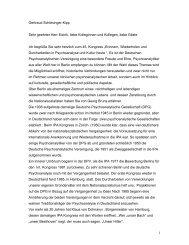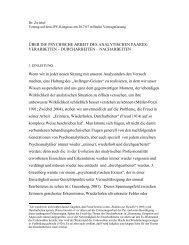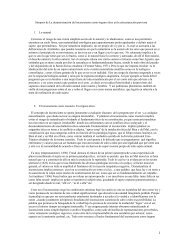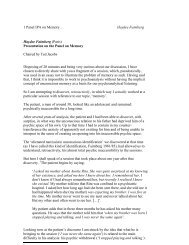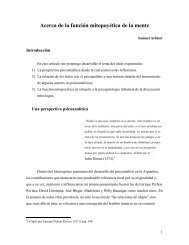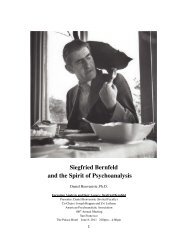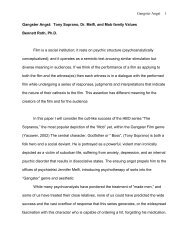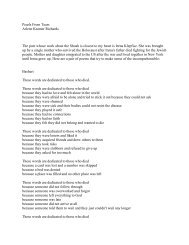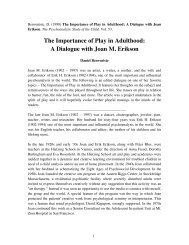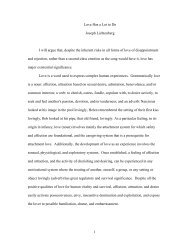Emanuel Windholz: The Institute Builder - International Psychoanalysis
Emanuel Windholz: The Institute Builder - International Psychoanalysis
Emanuel Windholz: The Institute Builder - International Psychoanalysis
You also want an ePaper? Increase the reach of your titles
YUMPU automatically turns print PDFs into web optimized ePapers that Google loves.
Unpublished<br />
<strong>Emanuel</strong> <strong>Windholz</strong>:<br />
<strong>The</strong> <strong>Institute</strong> <strong>Builder</strong><br />
July 1994<br />
Daniel Benveniste<br />
<strong>The</strong> establishment of the San Francisco Psychoanalytic Society and <strong>Institute</strong> was<br />
definitely a group effort and yet, of all the early San Francisco analysts, <strong>Emanuel</strong><br />
<strong>Windholz</strong> was probably more responsible than anyone else for the initiative, guidance<br />
and shape of the <strong>Institute</strong> during its first 40 years. He was seen by many as a passionate<br />
advocate for psychoanalysis, an uncommonly intuitive analyst, an inspiring lecturer, a<br />
powerful organizing force, and a kind and generous man. He developed a high profile by<br />
never shying away from controversy and was also ambitious and productive enough to<br />
have his critics. He was, more than anyone else, the <strong>Institute</strong> <strong>Builder</strong>.<br />
<strong>Emanuel</strong> <strong>Windholz</strong> was born on March 13, 1903 in Hronec, Czechoslovakia. He was the<br />
youngest of five children in a Jewish family in Bohemia (Czechoslovakia). His father,<br />
Pinkus <strong>Windholz</strong>, owned a grocery store in the small Bohemian village of Hronec. His<br />
mother, Jeanette, kept house and worked in the store, as did everyone in the family. He<br />
had one brother and three sisters. His eldest sister was instrumental in his upbringing and<br />
was later killed by the Nazis. <strong>Emanuel</strong> was recognized as a bright and sometimes<br />
mischievous child. At age seven, he was sent away from home to get his education<br />
attending Catholic schools. His older brother, Joseph, remained at home to work in the<br />
family store but died in 1921 from wounds he suffered during World War I (1,2,3).<br />
While still in the Gymnasium, <strong>Windholz</strong> began reading Freud. He completed his basic<br />
education in Kremnika, Slovakia on July 10, 1920 and took one course at Masaryk<br />
University Medical School in Brno, Czechoslovakia. He then went on to attend Charles<br />
University in Prague where he studied medicine from 1921-26. He spent one of those<br />
years studying medicine in Paris. He was in training for five years and graduated with his<br />
medical degree on December 17, 1926. He was the only one in his family to attain such<br />
an advanced education. Upon completion of his medical training he did a residency under<br />
Dr. Pelnar, at a small sanitarium outside of Prague, the Internal Clinic of Charles<br />
University in 1927. It was there that he met his life-long friend Dr. Jan Frank. Frank also<br />
became an analyst and later settled in New York. From 1927-29 <strong>Windholz</strong> was the Chief<br />
Assistant, under Dr. Jaroslav Stuchlik, at the State Hospital for Nervous and Mental<br />
Disorders in Kosice. He was Chief Resident at Kramer Sanitarium for Nervous and<br />
Mental Disorders from 1929-31. Following his residency <strong>Windholz</strong> opened a private<br />
practice in the treatment of "neurotic and mental diseases" in Prague. He had an office<br />
located at Stepanska 28 and later at Jungmannova str. 9. He was a member of the Medical<br />
Chamber of Bohemia, the Czechoslovakia Medical Association, and the Psychoanalytic<br />
Society of Switzerland (1, 2, 3, 4).
In the summer of 1930 <strong>Windholz</strong> went to Berlin to study psychoanalysis and begin a<br />
personal analysis. His analyst was Dr. Moshe Wulff, a Russian analyst who emigrated to<br />
Tel Aviv in 1933. During this summer <strong>Windholz</strong> worked at the Berlin Policlinic and was<br />
accepted for training at the Berlin Psychoanalytic <strong>Institute</strong>. At the end of the summer,<br />
Moshe Wulff and Ernst Simmel told him he should return to Prague and begin practicing<br />
psychoanalysis. He was astounded to think he should begin practicing on his own after an<br />
"internship" of only a few months. He returned to Czechoslovakia to work at a small<br />
sanitarium outside of Prague,. He also opened a private practice, listed himself in the<br />
phonebook as a student of the Berlin Psychoanalytic <strong>Institute</strong>, and began seeing patients.<br />
He and his patients were ridiculed for their psychoanalytic undertakings by the chief of<br />
the sanitarium but such ridicule did not stop patients from inundating <strong>Windholz</strong> with<br />
requests for treatment (1,5).<br />
Some time after <strong>Windholz</strong>'s return to Prague, the German analyst, Mrs. Francis Deri, left<br />
Berlin and came to set up practice in Prague. <strong>Windholz</strong> soon entered into analysis with<br />
her. He was fond of recalling that Deri, who was staying in a pension, at that time, used<br />
her bed as an analytic couch. <strong>Windholz</strong> had the first appointment of the day and his<br />
knock on the door apparently often served to awaken her. She would get out of bed, put<br />
the blankets in order and welcome her first patient into her "office." <strong>Windholz</strong> would<br />
enter her room, lie down and notice that the bed was still warm. <strong>The</strong> warm bed, of course,<br />
gave rise to a flood of new fantasies (1).<br />
Mrs. Deri also supervised <strong>Windholz</strong>'s work with his own patients. Deri and <strong>Windholz</strong><br />
began giving lectures. <strong>Windholz</strong> gave a lecture series (10 lectures) entitled An<br />
Introduction to <strong>Psychoanalysis</strong> with ten students in attendance. Deri gave a lecture on<br />
<strong>The</strong> Interpretation of Dreams with twenty attendees and another on <strong>The</strong> Fundamental<br />
Principles of <strong>Psychoanalysis</strong> with 100 attendees! Deri and <strong>Windholz</strong> then gathered<br />
together a few other students and began a project to have some of Freud's writings<br />
translated into Czech. This project necessitated a trip to Vienna where <strong>Windholz</strong> met with<br />
Sigmund Freud for the first time to request permission to do a translation of Freud's<br />
Psychoanalytical History of Illness into Czech. Permission was granted. <strong>Windholz</strong> noted<br />
that what struck him most about this meeting was Freud's uncanny observational abilities<br />
(1, 6).<br />
In May of 1931, <strong>Windholz</strong> sent a birthday greeting of some sort to Sigmund Freud and in<br />
return received a printed thank you card signed by Freud (4).<br />
On Sunday, October 25, 1931 there was an "Unveiling of a Memorial Tablet at the Birth<br />
House of Professor Dr. Sigmund Freud in Pribor-Freiberg, Moravia." Though Sigmund<br />
Freud was unable to attend, it was an event of great importance and pleasure to him. He<br />
sent to this event a delegation of his son, Martin; daughter, Anna; and his brother,<br />
Alexander Freud. <strong>The</strong>re were seven speeches including Freud's acceptance speech, read<br />
by Anna Freud. <strong>The</strong> other speakers were F. Slabihoudek, Juranem, Benes, Paul Federn,<br />
Max Eitington, and <strong>Emanuel</strong> <strong>Windholz</strong> who had played an important role in the<br />
organization of this event (7,8).
<strong>Windholz</strong> also edited and published a collection of papers on psychoanalysis, written by<br />
Czech authors, in honor of Freud's 75th birthday. This little book, written in Czech,<br />
includes an introduction by <strong>Windholz</strong> and two additional chapters that he wrote. One is<br />
entitled <strong>The</strong> Psychoanalytic Treatment and the other, <strong>The</strong> Structure of Personality and the<br />
Application of <strong>Psychoanalysis</strong>. <strong>The</strong> book also includes photographs of the unveiling of<br />
the plaque at Freud's birth house and the speakers giving their speeches. In the private<br />
archive of Dr. Michael <strong>Windholz</strong> is a copy of this book, signed by Sigmund Freud. <strong>The</strong><br />
book is entitled Sbornik psychoanalytichych praci (4, 7).<br />
In the early 1930s the political situation in Germany was rapidly deteriorating and many<br />
of the German analysts and students of analysis were leaving Berlin for more hospitable<br />
countries. In October 1933 the Czecho-Slovakian Study Group was formed and this<br />
group included Steff Bornstein, Francis Deri, Jan Frank, Elizabeth Gero-Heymann, Edith<br />
Gluck, Hannah Heilborn, Richard Karpe, Heinrich and Yela Lowenfeld, Christine Olden,<br />
Annie Reich, and <strong>Emanuel</strong> <strong>Windholz</strong>. <strong>The</strong> study group also had guest lectures delivered<br />
by August Aichorn, Edward Bibring, Paul Federn, Otto Fenichel, Ernst Kris, Rene Spitz,<br />
and Robert Waelder. Meetings were held in Deri's apartment on Jacna Street. (1,6,9)<br />
<strong>The</strong> sudden increase in the size of the Prague Study Group was, of course, a result of<br />
émigrés fleeing Nazi Germany. To facilitate Steff Bornstein's emigration to<br />
Czechoslovakia, <strong>Emanuel</strong> <strong>Windholz</strong> married her. <strong>The</strong>re was no romantic relation<br />
between them but this marriage insured her safety. In her article, in the Almanach der<br />
Psychoanalyse 1938, her authorship is listed as Steff Bornstein-<strong>Windholz</strong> (1).<br />
In 1934 the Prague Study Group officially affiliated with the Vienna Society at the<br />
<strong>International</strong> Psycho-Analytical Congress in Lucerne. In 1935 Otto Fenichel emigrated<br />
from Berlin to Prague, via Oslo. In April of 1935, Deri left Prague to immigrate to Los<br />
Angeles. She turned over the direction of the Study Group to Otto Fenichel. <strong>Windholz</strong><br />
described this as the most exciting time in his life. He was being analyzed and supervised<br />
by Fenichel. <strong>The</strong> study group met three evenings a week in cafes where long discussions<br />
continued late into the night. Weekends were spent with visiting instructors from<br />
<strong>Institute</strong>s outside the country. <strong>Windholz</strong> was President of the Prague Psychoanalytic<br />
Study Group from 1936-39.<br />
<strong>The</strong> translation project came to fruition in 1936 when Freud's Psychoanalytical History of<br />
Illness was translated into Czech by Dr. Ota Friedman. Dr. Friedman acknowledged<br />
receiving assistance in the translation from Hugo Bondy, Terezie Bondy, Steff Bornstein,<br />
Richard Karpe and <strong>Emanuel</strong> <strong>Windholz</strong>. It was published under the Czech title<br />
Psychoanalytike Chorobopisy. In April 1938 Fenichel left Prague for Los Angeles and<br />
laid the mantle of leadership on the shoulders of <strong>Emanuel</strong> <strong>Windholz</strong>. <strong>Windholz</strong> was 35<br />
years old (3,6,8,9,10).<br />
<strong>The</strong> Prague Study Group continued under <strong>Windholz</strong>'s leadership but most of the analysts<br />
had already left. Only the library and a few study group members remained. Within the<br />
deteriorating political situation the study group continued and <strong>Windholz</strong> married his<br />
second cousin, Lilly (Lilla) Epstein. <strong>The</strong> Nazi threat loomed larger and larger until March
1939 when Germany marched into Czechoslovakia and declared it a German<br />
"Protectorate." <strong>The</strong> remaining members of the Study Group finalized their plans for<br />
emigration. Jan Frank went to New York, Richard Karpe to Hartford Connecticut, the<br />
Lowenfelds to New York, Kristine Olden to Los Angeles, and <strong>Emanuel</strong> <strong>Windholz</strong>,<br />
carrying with him the Prague Psychoanalytic Study Group Library, emigrated to San<br />
Francisco with his wife (1,8).<br />
When the <strong>Windholz</strong>s arrived in San Francisco they stayed with Otto and Anna Maenchen,<br />
in Berkeley, until they could get a flat of their own in San Francisco on California Street.<br />
In order to be licensed, <strong>Windholz</strong> completed a medical internship at Mt. Zion Hospital<br />
from 1939-40. Later they moved into a flat on Union Street. <strong>The</strong> <strong>Windholz</strong>s had two<br />
children, Suzanne, born in 1941, and Michael, born in 1947 (1,8).<br />
In San Francisco <strong>Windholz</strong> joined a small psychoanalytic study group led by Siegfried<br />
Bernfeld who had emigrated from Vienna in 1937. Others in this group included<br />
Bernhard Berliner (from Berlin), Anna Maenchen (from Vienna and Berlin), Donald<br />
Macfarlane (trained by Berliner in San Francisco), Erik Erikson (from Vienna), and a<br />
number of interested others who were not analysts. This study group, originally under the<br />
auspices of the Chicago Psychoanalytic <strong>Institute</strong> and later under the Topeka<br />
Psychoanalytic <strong>Institute</strong>, was called the "Technical Seminar." <strong>The</strong>y discussed a wide<br />
range of topics including one of <strong>Windholz</strong>'s patients who had been silent for months at a<br />
time over a period of two and a half years. <strong>The</strong>se meetings took place regularly and met<br />
in the participant's homes. <strong>The</strong>y usually met at the home of the Bernfelds in the Marina<br />
District but they also met at the Berliners' or the Maenchens'.(11)<br />
Meanwhile Otto Fenichel, Hannah (Heilborn) Fenichel, Ernst Simmel, Francis Deri,<br />
Christine Olden and others had already formed their own study group in Los Angeles. On<br />
Saturday and Sunday, March 30-31, 1940, the San Francisco and Los Angeles analysts<br />
met at the Foothills Hotel in Ojai, California for the first meeting of the West Coast<br />
Psychoanalysts. <strong>The</strong> next meeting took place on September 14-15, 1940 at the Hotel<br />
Plaza in San Francisco. <strong>The</strong>re were a variety of presentations made at this meeting but it<br />
is particularly noteworthy that there was a Symposium on Neurotic Disturbances of Sleep<br />
that featured presentations by Fenichel, <strong>Windholz</strong>, Haenel, Olden, Deri, Maenchen,<br />
Berliner, and Simmel. <strong>The</strong> papers were subsequently published in <strong>The</strong> <strong>International</strong><br />
Journal of <strong>Psychoanalysis</strong> 1942, Vol. 23, No. 2 (11, 12).<br />
In December of 1940 the formation of a Psychoanalytic Society and <strong>Institute</strong> was very<br />
much on the minds of the West Coast analysts but there were two major issues that<br />
needed to be addressed. <strong>The</strong> first was the issue of lay analysis. In 1938 the American<br />
Psychoanalytic Association passed the resolution against the future training of laymen for<br />
the therapeutic use of psychoanalysis. This had an enormous impact on psychoanalysis in<br />
America for the next 50 years, and it had immediate consequences for the early West<br />
Coast analysts as many of the major analysts, like Bernfeld, Erikson, Deri, Olden,<br />
Maenchen, and others, were lay analysts and many of the émigré M.D. analysts like<br />
Fenichel and Simmel still needed to do internships to be licensed in California.
<strong>The</strong> second hotly debated issue was the nature of the organization of the <strong>Institute</strong>. Would<br />
it be highly organized as the Berlin <strong>Institute</strong> had been or would it be more informal like<br />
the Vienna <strong>Institute</strong> had been in its earlier years? Bernfeld, the leading analyst in San<br />
Francisco, was a lay analyst in favor of lay analysis and a more informal <strong>Institute</strong>.<br />
<strong>Windholz</strong>, on the other hand was an M.D. who favored a more organized <strong>Institute</strong>. He<br />
was sympathetic to the cause of lay analysis but was also eager to build an <strong>Institute</strong>, even<br />
if it had to be in accordance with the guidelines of the American Psychoanalytic<br />
Association, which excluded the lay analysts.<br />
In Otto Fenichel's Rundbriefe (an underground series of letters addressing psychoanalytic<br />
issues and politics which he distributed to his friends and close colleagues) he wrote<br />
about these issues often and specifically identified <strong>Windholz</strong> as agreeing with his pro-layanalysis<br />
stance. Nonetheless, anyone who wanted to establish an <strong>Institute</strong>, in those days,<br />
had to play by the rules of the American Psychoanalytic Association. To do otherwise<br />
was to become marginalized. <strong>The</strong> émigré analysts were fleeing Nazi Germany and<br />
Austria, learning a new language and settling in a new land. <strong>The</strong>y were professionally at<br />
sea, financially unstable and had families to feed. <strong>The</strong> need to legitimate psychoanalysis<br />
was urgent and attempts to do so were often desperate and, regretfully, at the expense of<br />
their non-medical colleagues (11, 21).<br />
Ultimately <strong>Windholz</strong> and the American Psychoanalytic Association agenda prevailed.<br />
<strong>The</strong> existing lay analysts were given "Honorary Memberships" or "Accredited Lay<br />
Analyst" status, no other lay analysts were to be trained and in 1942 the San Francisco<br />
Psychoanalytic Society was established in accordance with the guidelines of "the<br />
American." Its members were primarily located in Los Angeles and San Francisco but a<br />
few were in Tucson, Arizona and Seattle, Washington. <strong>The</strong> Charter members were<br />
William Barrett, Bernhard Berliner, Otto Fenichel, George Gero, Bernard Kamm, Jasha<br />
Kasanin, Donald Macfarlane, Douglass Orr, Ernst Simmel, and <strong>Emanuel</strong> <strong>Windholz</strong><br />
(11,13). <strong>The</strong> San Francisco Psychoanalytic Society and <strong>Institute</strong> were established, the<br />
“lays” were marginalized and while the bad feelings persisted the controversy between<br />
<strong>Windholz</strong> and Bernfeld was administratively resolved. Two years later Bernfeld would<br />
begin privately training analysts outside the structure of the SFPI and in flagrant violation<br />
of the rules of the American. Bernfled later resigned from the training committee and<br />
delivered a legendary two-part lecture entitled On Psychoanalytic Training in which he<br />
put forth his ideas about a preferred mode of psychoanalytic training only months before<br />
his death. His lectures were posthumously published in 1962 in the Psychoanalytic<br />
Quarterly.<br />
For the purposes of licensure, <strong>Windholz</strong> did an internship at Mount Zion Hospital from<br />
1939-40. During the war years (World War II), he was Chief Psychiatrist at the Veterans<br />
Rehabilitation Clinic of Mount Zion Hospital under the Directorship of Jasha (Jacob)<br />
Kasanin. It was there that Kasanin brought together dieticians, recreation assistants,<br />
social workers, psychologists, psychiatrists, psychoanalysts and Jungian analysts to<br />
address the psychiatric rehabilitation of returning veterans from the Second World War<br />
(3,15).
At this clinic San Francisco analysts developed short term psychoanalytic treatments for<br />
dealing with the enormous influx of psychiatrically impaired veterans. Vocational<br />
rehabilitation plans were devised taking into consideration the patient's neurotic problems<br />
rather than ignoring these features, as had previously been the custom. And <strong>Windholz</strong><br />
developed an intensive application of group therapy for returning veterans. <strong>The</strong>y also<br />
used hypnosis and pentothal treatments (15, 16).<br />
In 1946 the Los Angeles group made a planned and friendly split from the San Francisco<br />
Psychoanalytic Society and <strong>Institute</strong> to establish their own Society and <strong>Institute</strong>. Semiannual<br />
joint meetings of the two Societies, however, continued for a time.<br />
<strong>The</strong> San Francisco Psychoanalytic <strong>Institute</strong> and Society continued to grow despite the ongoing<br />
controversies regarding lay analysis and the organization of the <strong>Institute</strong>. Policies,<br />
procedures, committees, rules, and regulations proliferated often in the service of the<br />
training and, by some accounts, sometimes to its detriment.<br />
<strong>Windholz</strong> had a higher profile and wielded more power than any other analyst in the<br />
<strong>Institute</strong>. He trained many analysts and promoted them into positions within the<br />
organization of the <strong>Institute</strong>. Having a strong personality and wielding power in the<br />
<strong>Institute</strong> he became for some a person to love, admire and emulate and for others a<br />
worthy opponent. Whatever the relation, <strong>Windholz</strong> was, more than anyone else, the<br />
<strong>Institute</strong> <strong>Builder</strong> and a person with whom one had to deal.<br />
<strong>Windholz</strong> was very active in <strong>Institute</strong> politics. He was the Society's second President<br />
from 1944-1946, was appointed Training Analyst in 1946, and was elected President of<br />
the <strong>Institute</strong> from 1956-58. He was Chairman of the Education Committee from 1947-56,<br />
and on the Committee on Progression and Graduation from 1960-66. He was on the<br />
Research Team with the Psychotherapy Evaluation and Study Center of the SFPI<br />
beginning in 1976. He promoted the <strong>Institute</strong>'s Low Fee Clinic for the public and the<br />
Moderate Fee Clinic for psychologists and social workers. He was instrumental in raising<br />
money for these clinics and later in raising money for the purchase of a building to house<br />
the <strong>Institute</strong>.<br />
Factions within psychoanalytic societies frequently fall into controversy over matters<br />
such as theory, technique, admissions, institute organization and teaching styles. <strong>The</strong><br />
SFPI was no exception in this regard and, as stated earlier, <strong>Windholz</strong> never shied away<br />
from controversy. It has been emphasized by some, that <strong>Emanuel</strong> <strong>Windholz</strong> always met<br />
controversy by standing on the side of inclusion. He attempted to build consensus and<br />
promote dialogue to avoid splits, rejections and expulsions. <strong>The</strong>re were, however, two<br />
exceptions to this rule. <strong>The</strong> first exclusion pertains to the early controversy between<br />
<strong>Windholz</strong> and Bernfeld over the issue of lay analysis and specifically the refusal to grant<br />
training analyst status to Bernfeld's wife, Suzanne Bernfeld, who was a lay analyst,<br />
analyzed by Hanns Sachs and Sigmund Freud. She was considered a brilliant analyst by<br />
some but others felt she was inadequately trained. A second exclusion pertained to the<br />
removal of "training analyst" status from an analyst in the early 1960s. <strong>Windholz</strong> appears<br />
to have been in favor of both of these exclusions. In subsequent years, however,
whenever exclusion became an issue, <strong>Windholz</strong> is said to have stood on the side of<br />
inclusion. He disagreed with the proposal to lower the retirement age for training<br />
analysts; fought the exclusion of analysts and training analysts who held viewpoints that<br />
were not "classical" in orientation; opposed the exclusion of those with viewpoints closer<br />
to the Kleinian position; warded off threats to split the <strong>Institute</strong>; was interested in new<br />
ideas, developmental points of view and new research strategies; and without necessarily<br />
agreeing with them he supported the people who considered alternative psychoanalytic<br />
viewpoints. He struggled to be a consensus builder, which, of course, is both a difficult<br />
and unpopular position to maintain. (1)<br />
In the American Psychoanalytic Association <strong>Windholz</strong> was Chairman of the Membership<br />
Committee from 1948-51, member of the Executive Council from 1951-57 and again<br />
from 1960-64. He founded the Committee on Psychoanalytic Education in 1959, was<br />
Councilor at Large on the Executive Council from 1951-57 and again from 1960-64. He<br />
was Chairman of the Study Group on Supervision from 1964-70 and was also a member<br />
of the editorial board of the Journal of the American Psychoanalytic Association from<br />
1955-63 (4).<br />
He was a member of the Board of Directors of the Jewish Committee for Personal<br />
Service and worked with them as a consultant in the San Francisco jails and at San<br />
Quentin. Of course, he also had a private practice. His first two patients were sent to him<br />
by psychologist, Nathan Adler, who also worked at the Jewish Committee for Personal<br />
Service and was in supervision with <strong>Windholz</strong>. <strong>Windholz</strong>'s first office was located at<br />
1809 California, later at 2686 Union Street, then at 2235 Post Street where he was in the<br />
same building with Erik Erikson, the pediatrician Ernst Wolff, and internist Leona M.<br />
Bayer. Drs. Wolff and Bayer were husband and wife, and very sympathetic to<br />
psychoanalysis. Later Norm Reider moved into their building and their office became the<br />
headquarters for the Society and <strong>Institute</strong>, complete with the secretarial services of the<br />
famous Jennie Chiado, who worked for the <strong>Institute</strong> for over 40 years. Later when the<br />
<strong>Institute</strong> moved to 2420 Sutter Street <strong>Windholz</strong> moved his office into one of the private<br />
office spaces in the <strong>Institute</strong> building (4).<br />
<strong>Windholz</strong> was involved in the training of psychiatric residents and social workers at the<br />
Veteran's Rehabilitation Clinic at Mt. Zion from 1943-47. He was a clinical professor of<br />
Psychiatry at the University of California from 1945 until his death. He trained<br />
psychiatric interns at Langley Porter Neuropsychiatric <strong>Institute</strong> from 1945-71, at Mt.<br />
Zion Hospital from 1945-75, at Letterman Hospital from 1948-71, and at the U.S. Naval<br />
Hospital in Oakland from 1951-53. Students loved his clinical conferences and were<br />
inspired by his discussion of cases. <strong>The</strong>y were charmed and thrilled by his manner and he<br />
left a lasting impact on their training that many remember fondly to this day. <strong>The</strong>y<br />
packed the conference rooms when he spoke and many made their decisions to become<br />
analysts while sitting in his seminars. He spoke eloquently on the theory of narcissism<br />
and is remembered by some as offering particularly creative insights into narcissistic<br />
character pathology (1, 4,17, 18, 19).<br />
He was more of a teacher than a writer but his collected works include the following
papers:<br />
<strong>The</strong> Publications of <strong>Emanuel</strong> <strong>Windholz</strong><br />
In Czech:<br />
(19??) <strong>The</strong> Vegetative Nervous System of Epileptics, Experimental Studies with<br />
Pilocarpine, Vestnik Spolku csl. Lekaru Kosicich, 6,4.<br />
(19??) Treatment of Epilepsy with Salamandrine, Vestnik Spolku csl. Lekaru<br />
Kosicich, 7,3.<br />
(19??) Paranoid Reactions and their Relation to Anal Character, with Dr. J.<br />
Stuchlik, Vestnik Spolku csl. Lekaru Kosicich, 8,1.<br />
(1931) Sbornik psychoanalytickych praci, (This book was published in honor of<br />
Sigmund Freud's 75th Birthday. It was edited by <strong>Emanuel</strong> <strong>Windholz</strong> and includes<br />
three contributions by him. <strong>The</strong> first is an Introduction. <strong>The</strong> second is a chapter on<br />
<strong>The</strong> Psychoanalytic Treatment in which he offers a brief description of the<br />
concept of neurosis, followed by a discussion of the treatment process illustrated<br />
with case histories and a discussion of the indications and limitations of<br />
psychoanalytic treatment and its relation to other types of psychotherapy. <strong>The</strong><br />
third is a chapter on the Structure of Personality and the Application of<br />
<strong>Psychoanalysis</strong> in which he discusses the concepts of the "conscious" and<br />
"unconscious," the development of the ego and superego, the biological basis of<br />
psychoanalysis, and provides descriptions of character neuroses, impulse neuroses,<br />
and depressions. He then discusses the importance of psychoanalysis to the fields<br />
of criminology, psychology, sociology, and biography. He illustrates his<br />
biographical assertion with examples from the works of Balzac, George Sand, and<br />
a number of Czech writers. An analysis of the relationship between Verlain and<br />
Rimbaud is given substantiating the suspicion of homosexuality and another<br />
section is devoted to the psychoanalytic interpretation of the modern art of Jean<br />
Frois-Wittman. Additional chapters in this book are written by Fr. Bennes, Dr. Jar<br />
Stuchlik, Dr. Osipov, Dr. Fr. Slabihoudek, and Dr. Jan Frank.<br />
(1934) <strong>Psychoanalysis</strong> and Medicine, Lekarska Revue, 1,4.<br />
(1936) Psychoanalyticke´ Chorobopisy (Translation of Freud's "Vier<br />
Psychoanalytischekrankengeschichten" or "Psychoanalytic History of Patients."<br />
It includes the case histories of Dora, Little Hans, the "Rat man" and the Schreber<br />
case.) - It was translated into Czech by Dr. Ota Friedmann with the assistance of<br />
Dr. Hugo Bondy, Dr. Terezie Bondy, Mrs. Steff Bornstein, Dr. Richard Karpe and<br />
Dr. <strong>Emanuel</strong> <strong>Windholz</strong>. Julius Albert, Praha.<br />
In English:<br />
(1942) Symposium on Neurotic Disturbances of Sleep, <strong>International</strong> Journal of<br />
<strong>Psychoanalysis</strong>, Vol. 23, No. 2.<br />
(1944) When Johnny Comes Marching Home, Beacon: <strong>The</strong> Bulletin of the Mental<br />
Health Society of Northern California, Vol. 3, No. 3.<br />
(1945) Observations on the Psychiatric Rehabilitation of Veterans, Bulletin of the<br />
Menninger Clinic, Vol. 9, No. 4.<br />
(1947) Criteria of <strong>The</strong>rapy of War Neuroses, with Jasha Kasanin and Charl Rhode,<br />
American Journal of Psychiatry, Vol. 104, No. 4.
(1949) Countertransference and Attitudes of the Analyst in the <strong>The</strong>rapeutic<br />
Process, presentation by Leo Berman, MD, Discussion, Bulletin of the American<br />
Psychoanalytic Association, Vol. 5, No. 2.<br />
(1951) Current Problems of Psychoanalytic Technique, Panel Presentation,<br />
Bulletin of the American Psychoanalytic Association, Vol. 7, No. 3.<br />
(1951) On Depressive States, Panel Presentation, Bulletin of the American<br />
Psychoanalytic Association, Vol. 7, No. 4.<br />
(1954) <strong>Psychoanalysis</strong> and Dynamic Psychotherapy, Panel Presentation, Journal<br />
of the American Psychoanalytic Association, Vol. 2, No. 1.<br />
(1955) Problems of Termination of the Training Analysis, Journal of the<br />
American Psychoanalytic Association, Vol. 3, No. 2.<br />
(1956) Technique of Supervised Analysis, Panel Presentation, Journal of the<br />
American Psychoanalytic Association, Vol. 4, No. 3.<br />
(1957) Acting Out and Its Relation to Impulse Disorders, Panel Presentation,<br />
Journal of the American Psychoanalytic Association, Vol. 5, No. 1.<br />
(1957) Technique of Supervised Analysis, Panel Presentation, Journal of the<br />
American Psychoanalytic Association, Vol. 5, No. 3.<br />
(1958) Technical Aspects of Regression During <strong>Psychoanalysis</strong>, Panel<br />
Presentation, Journal of the American Psychoanalytic Association, Vol. 6, No. 3.<br />
(1959) Problems of Reanalysis, Panel Presentation, Journal of the American<br />
Psychoanalytic Association, Vol. 7, No. 3.<br />
(1962) <strong>The</strong> Psychoanalytic Situation, <strong>International</strong> Journal of the Psycho-Analysis,<br />
Vol. 43, Parts 4-5.<br />
(1962) Future Plans of the Committee on Psychoanalytic Education, Journal of<br />
the American Psychoanalytic Association, Vol. 10, No. 1.<br />
(1963) Some Technical Problems of Character Analysis, Journal of the Hillside<br />
Hospital, Vol. 12, No. 1.<br />
(1963) Analysis Terminable and Interminable, Panel Presentation, Journal of the<br />
American Psychoanalytic Association, Vol. 11, No. 1.<br />
(1966) Working Through, Panel Presentation, Journal of the American<br />
Psychoanalytic Association, Vol. 14, No. 1.<br />
(1966) Severe Regressive States During Analysis, Panel Presentation, Journal of<br />
the American Psychoanalytic Association, Vol. 14, No. 3.<br />
(1970) <strong>The</strong> <strong>The</strong>ory of Supervision in Psychoanalytic Education, <strong>International</strong><br />
Journal of Psycho-Analysis, Vol. 51, Part 3.<br />
(1971) Some Specific Transference, Countertransference and Supervisory<br />
Problems in the Analysis of a Narcissistic Personality, with Jerome Oremland,<br />
<strong>International</strong> Journal of Psycho-Analysis, Vol. 52, Part 3.<br />
(1972) Continuing Research: Modification of Defenses, Panel Presentation,<br />
Journal of the American Psychoanalytic Association, Vol. 20, No. 1.<br />
(1972) Ten Years of COPE: Perspectives in Psychoanalytic Education, Journal of<br />
the American Psychoanalytic Association, Vol. 20, No. 4.<br />
(1979) <strong>The</strong> Inscrutable Jennie Chiado, Dialogue: A Journal of Psychoanalytic<br />
Perspectives, Vol. 3, No.2.<br />
(1981) Application: <strong>The</strong> San Francisco Project - <strong>The</strong> Supervisor at Work, in<br />
Becoming a Psychoanalyst, Ed. Robert S. Wallerstein, <strong>International</strong> Universities
Press, Inc.<br />
(1985) Consensual Analysis: An Introduction,<br />
Consensual Analysis: Current Findings and Future Implications, Appendix C -<br />
Excerpts From a Case Study of an Hysterical Character,<br />
Appendix D - <strong>The</strong> Intuitive Understanding of a Transference Paradigm,<br />
Appendix E - Consensual Analysis: <strong>The</strong> Multiple Appeal of Interpretations, in<br />
New Ideas in <strong>Psychoanalysis</strong>: <strong>The</strong> Process of Change in a Humanistic<br />
Science. Ed. C. Settlage & R. Brockbank, <strong>The</strong> Analytic Press.<br />
<strong>Windholz</strong>'s later papers on psychoanalytic supervision, a topic on which he had a great<br />
deal to say, are surprisingly few and deceptively brief. Psychoanalytic supervision was a<br />
passion for which he had a great deal to say but it was always easier for him to speak<br />
about his ideas than it was for him to write about them. In these later papers he<br />
introduced a research approach to understanding psychoanalysis through an innovative<br />
strategy akin to "supervision," which he called "Consensual Analysis." It was, in fact, not<br />
supervision at all. It was called Consensual Analysis as it involved two analysts who<br />
agreed to observe an analysis. In Consensual Analysis the treating analyst saw his patient<br />
four times a week and wrote extensive process notes on the patient hours. <strong>The</strong>se were<br />
then passed on to <strong>Windholz</strong> at the end of the week. <strong>The</strong> treating analyst would then go to<br />
see <strong>Windholz</strong> once a week to speak about the analysis. Unlike supervision, however,<br />
<strong>Windholz</strong> remained completely silent from beginning to end. <strong>The</strong>se meetings were audio<br />
recorded, transcribed and years later these transcripts were compared to the analyst's<br />
written reports in a seminar led by <strong>Windholz</strong> and the treating analyst. Among other<br />
findings, it was found that the treating analyst seemed to pay more attention to his<br />
emotional involvement with the patient in his meetings with <strong>Windholz</strong> than he did in his<br />
process notes. This led to an increased awareness of what is referred to these days as the<br />
clinical significance of enactments, evoked transferences, and so on. <strong>The</strong>y studied how<br />
the unconscious of the analyst works and how it interacts with the unconscious of the<br />
analysand, attending to what is forgotten and what is remembered by the treating analyst<br />
and tracking the transferences and countertransferences that were being generated in the<br />
room. It was an innovative piece of work for which he had a great passion in his final<br />
years. He dedicated long hours to going over the data and his conclusions inspired his<br />
colleagues (20).<br />
On May 20th 1986, at the age of 83, <strong>Emanuel</strong> <strong>Windholz</strong> died. In addition to the legacy<br />
that <strong>Windholz</strong> left behind in the form of published papers, numerous students, and an<br />
<strong>Institute</strong> that he was largely responsible for building, he also left behind a daughter,<br />
Suzanne Model, who is an Associate Professor of Sociology at the University of<br />
Massachusetts, and a son, Michael <strong>Windholz</strong>, who is a psychologist, psychoanalyst and a<br />
member of the San Francisco Psychoanalytic <strong>Institute</strong>.<br />
<strong>Emanuel</strong> <strong>Windholz</strong>, always at the heart of <strong>Institute</strong> politics, was one of the most<br />
controversial figures in the history of psychoanalysis in San Francisco. He was<br />
considered an inspiring teacher and supervisor by many. He was extraordinarily<br />
supportive and helpful to his loyal students. Though he was an ardent proponent of
classical analysis and described, by some, as being rigid, to a fault, he is said to have<br />
loosened up quite a bit during the last ten years of his life. His so called "rigidity" has<br />
also been contextualized by his supporters who couch it in terms of his formal, old world,<br />
European style on the one hand and his attempts to conform to the formalities of the<br />
American Psychoanalytic Association on the other. He was interested in new ideas in<br />
psychoanalysis but could be sharply critical of watered down approaches as well. Despite<br />
his reputed "rigidity" he was very supportive of the creative work of younger analysts in<br />
the <strong>Institute</strong> as they came upon innovative new ideas, approaches and research strategies.<br />
In the early days he was known as Doctor <strong>Windholz</strong> but in later years was referred to by<br />
his colleagues simply as "Windy."<br />
He is said to have had an extraordinary memory for clinical details, which was put to<br />
good use as a clinical supervisor and in his work with the APsaA Study Group on<br />
Supervision. He had an impressive memory for clinical material and clearly took pleasure<br />
in uncovering the infantile sexuality residing beneath the surface of this material. Loved<br />
and respected by his students and colleagues, many of them noted, at his memorial, that<br />
he was very private about the details of his own life. <strong>The</strong>y found he would always<br />
manage to turn around a question about how he was doing into an inquiry about their<br />
well-being. Nonetheless, he was found to be a generous man and a strong supporter of his<br />
students. He was also known to have been a very good dancer.<br />
<strong>Emanuel</strong> <strong>Windholz</strong>, psychiatrist, psychoanalyst, supervisor, teacher, administrator, writer,<br />
researcher, husband and father, colleague and friend, was a passionate advocate for<br />
psychoanalysis who received praise from many and formidable critiques from others. But<br />
in either case, <strong>Windholz</strong> must be recognized as one of the giants in the history of the San<br />
Francisco Psychoanalytic Society and <strong>Institute</strong>. He did not build the <strong>Institute</strong> single<br />
handedly. He built it along with Berliner, Simmel, Kasanin, Macfarlane, Bernfeld,<br />
Maenchen, Erikson, Barrett and the rest, but because of his active involvement in the<br />
administrative workings of the <strong>Institute</strong>, his extensive psychoanalytic teaching, the<br />
number of training analyses he conducted and the traditions he put into place and<br />
promoted through his students, it is more than justified to attribute to him the title - <strong>The</strong><br />
<strong>Institute</strong> <strong>Builder</strong>.<br />
----------------------------------------<br />
REFERENCES<br />
1) Biographical sketch by Michael <strong>Windholz</strong> for the June 8, 1986 Memorial Service for<br />
<strong>Emanuel</strong> <strong>Windholz</strong>; and the author's interviews with Michael <strong>Windholz</strong>.<br />
2) Statement of training for <strong>Emanuel</strong> <strong>Windholz</strong> - Medical Chamber for the Country of<br />
Bohemia - Prague January 13, 1939<br />
3) <strong>Emanuel</strong> <strong>Windholz</strong> Application form for San Francisco County Medical Society<br />
4) Michael <strong>Windholz</strong> personal archives and <strong>The</strong> <strong>Emanuel</strong> <strong>Windholz</strong> Archives at the San<br />
Francisco Psychoanalytic <strong>Institute</strong>.<br />
5) Heir geht das Leben auf eine sehr merkwurdige Weise weiter, Verlag Michael Kellner,<br />
Karen Brecht, et al, 1985. p.64.<br />
6) Czecho-Slovakian Study Group <strong>International</strong> Journal of <strong>Psychoanalysis</strong> - Vol. 16 Part<br />
3 - July 1935 - pp. 395-6.<br />
7) Sbornik psychoanalytickych praci (1931) edited by <strong>Emanuel</strong> <strong>Windholz</strong>.
8) Freud: A Life for Our Time - (1988) Peter Gay, p. 575<br />
9) <strong>The</strong> Prague Psychoanalytic Group - 1933-1939, by William Jeffery, <strong>The</strong> American<br />
Psychoanalyst, Vol. 25, No. 2.<br />
10) Psychoanalytike Chorobopisy, by Sigmund Freud, translated by Ota Friedman, Pub.<br />
Julius Albert, Praha, 1936<br />
11)<strong>Windholz</strong>, <strong>Emanuel</strong>, ( Monday June 10, 1957) Extemporaneous talk on the<br />
"Organization and Development of the San Francisco Psychoanalytic Society."<br />
12) Fenichel, O., et al., (1942) Symposium on Neurotic Disturbances of Sleep,<br />
<strong>International</strong> Journal of <strong>Psychoanalysis</strong>, Vol. 23, No. 2. Pp.49-68.<br />
13) Bulletin American Psychoanalytic Association, Vol. 1, June 1937-1938.<br />
14) From author's interview with Leona M. Bayer, M.D.<br />
15) Kasanin, J. (1945) <strong>The</strong> Organization of the Veterans Rehabilitation Clinic of the<br />
Mount Zion Hospital, Bulletin of the Menninger Clinic, July 1945, Vol. 9, No. 4.<br />
16) <strong>Windholz</strong>, E. (1945) Observations of Psychiatric Rehabilitation of Veterans, Bulletin<br />
of the Menninger Clinic, July 1945, Vol. 9, No. 4.<br />
17) APA Roster 1988-90<br />
18) SFPI Archives<br />
19) S.F. Chronicle Obituary<br />
20) (1985) New Ideas in <strong>Psychoanalysis</strong>: <strong>The</strong> Process of Change in a Humanistic<br />
Science. Ed. C. Settlage & R. Brockbank, <strong>The</strong> Analytic Press.<br />
21) Otto Fenichel - Rundbriefe - SFPI Archives.<br />
--------------------------------------------------------------------------------------------------<br />
Daniel Benveniste, Ph.D. is a clinical psychologist who lives and works in<br />
Bellevue, Washington.<br />
Correspondence concerning this article should be addressed to:<br />
E-MAIL – daniel.benveniste@gmail.com





